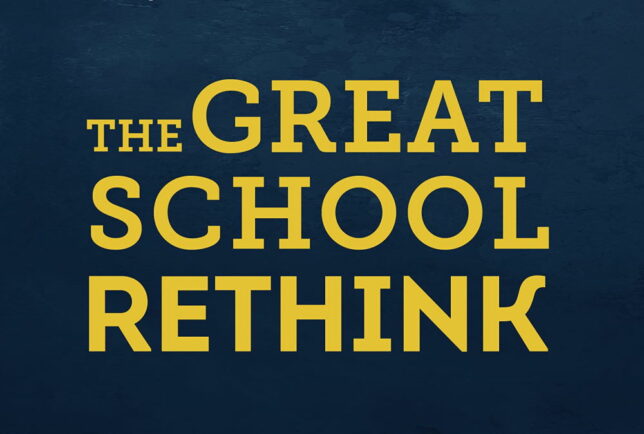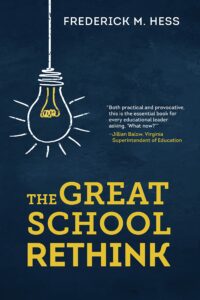Education Reform
A Much Needed but Partial Great School Rethink


School “reform” is probably only slightly younger than schooling itself. Americans have advanced numerous waves of education “reform” phases, from the very beginnings of government schooling under the Massachusetts Bay Colony’s Old Deluder Satan Acts through 19th-century efforts to grind Catholicism out of immigrant communities through the “scientific” Progressive Era up to more contemporary efforts to bring college to all, unsuccessfully.
Frederick Hess, director of education policy studies at the American Enterprise Institute, thinks schooling and school reform itself are due for a rethink. In his brief (less than 150 pages, excluding endnotes and acknowledgements) The Great School Rethink, Hess lays out his view on a new way to address the problems of American education, all informed by decades in the education policy field. If every superintendent, school board member, and principal in the country read it, the country would be better off.
But while it appears to this outsider to be an excellent guide to the practicum of incrementalist school improvement, it does not prepare its readers for the inevitability of conflict with those who benefit from refusing to rethink. At various stages, a reader may conclude that Hess has advanced a clever idea, but that Randi Weingarten and Becky Pringle (leaders of the two largest national teachers unions) will fight to the death to stop it. A reviewer must avoid the temptation to criticize a writer for not writing the book the critic would have preferred. Hess has written a perfectly good book for his purposes, but he left unaddressed conflicts that deserve a rethink of their own.
Good Thoughts
Hess identifies five “habits” of a “Rethinker” that should guide the analysis of schooling problems or opportunities for improvement. The rethinking-minded administrator, scholar, or educator should
- Ask “why” of as many practices or procedures as possible,
- Tackle problems with as much precision as possible,
- “Take a deep breath” and act deliberately rather than rashly,
- Seek new solutions to novel problems, and
- Avoid the temptation to change things the Rethinker does not understand for the sake of change alone.
Policymakers, scholars, and administrators beyond education would be wise to adhere to those habits of mind.
Hess walks through the history of various K–12 educational practices to illustrate how they may not fit the contemporary era. Academic credit hours? An artifact of the Carnegie Foundation’s desire to develop pensions for university professors. Summer break? Not an artifact of agriculture as commonly believed, but rather of urbanization in the era before modern sewage management. The structure of the teaching profession, with recent graduates hired out of colleges and graduate schools with an eye toward a 30-year career that few complete? An artifact of the “Common Schools” movement through the Progressive Era when female graduates were locked out of most other jobs. This does not exhaust Hess’s list of historical accidents that form the substrate of contemporary American education.
Since they derived by accident, things as fundamental as credit hours, the structure of teaching recruitment, and the school year can be rethought. Hess is not interested in a prescriptive tome; unlike other “reformers,” he prefers that his readers in positions of authority to work within the constraints of their local communities and their own schools. That is a “rethink” long overdue given the failures of the proponents of Common Core in the early Obama administration, among them the Bill and Melinda Gates Foundation.
Institutional Obstacles to Rethinking
But here I cannot avoid committing the cardinal sin of the reviewer. Hess’s analysis is perceptive; his processes practical. The education system—including private, charter, and public schools—would profit from a rise in Rethinkers.
But there is a grave omission. Hess does not address how to rethink the elephants in the room—the institutions that profit, proselytize, and prosper under the current regime.
The most obvious such interest is teachers unions. Hess spends a chapter, “Teaching Reconceived,” discussing how the structure of the teaching profession came to be and how it might be rethought. But the teachers unions will go to the wall to defeat rethinking policies like licensure rules or seniority-based pay to allow transfers from other professions to become teachers, denouncing such efforts as attacks on teachers per se.
Other institutions also profit from education-as-it-exists, not education-as-it-might-be-rethought. Institutional foundations like the Bill and Melinda Gates Foundation might promise revolutionary reforms, but they and their grantees operate from a top-down metrics-based approach suited for the factory-floor model of 20th century education. Liberal interest groups that influence school curriculums—consider the Planned Parenthood–endorsed sex education standards backed by Big Labor adopted by Washington State—benefit from the present system.
Choice, even course choice or choice among government schools, “for parents and educators alike to rethink how they want schools to work” is one of Hess’s brilliant ideas his Rethinkers will only enact over Randi Weingarten’s furious opposition. How does a Rethinker get around the institutions committed to not “rethinking? That question goes unaddressed in this volume.
Conclusion
Hess is right to focus a chapter on parent–educational system trust. The pandemic lockdowns and one-size-fits-all policies harmed children and made parents question whom schools served. It should be noted that most of the one-size-fits-all harm came from the lockdown-restrictionist side. The open-accommodationist side typically offered virtual options for those uncomfortable with reopening and normalcy.
Many parents and voters concluded that the answer to the question of whom schools served was not families but rather the elephantine permanent institutions of the education bureaucracy, first and foremost Randi Weingarten and the teachers unions. That is why numerous states have adopted education-choice legislation in the years following COVID-19 lockdowns.
But that bureaucracy continues to metastasize where it can. New York State adopted the following “culturally responsive-sustaining education framework” mission statement:
The responsibility of education is not only to prevent the exclusion of historically silenced, erased, and disenfranchised groups, but also to assist in the promotion and perpetuation of cultures, languages and ways of knowing that have been devalued, suppressed, and imperiled by years of educational, social, political, economic neglect and other forms of oppression.
With ideological activists burrowed so deeply in education policy making statements like that one, a Great School Rethink is definitely overdue. But even clearing the field for Hess-style Rethinkers to make their own mark on schooling will require a political ruthlessness, tactical nous, and willingness to combat that one must find in another book, perhaps one yet to be written.




